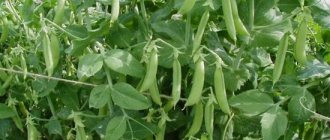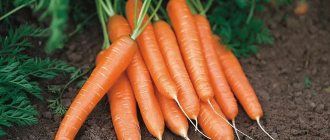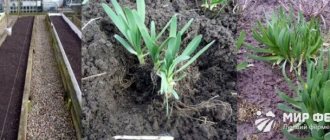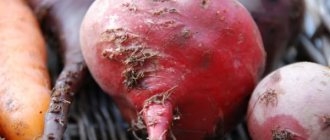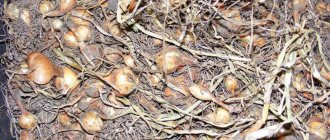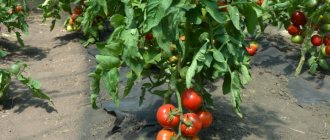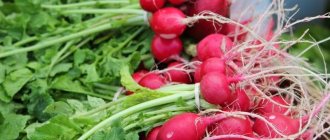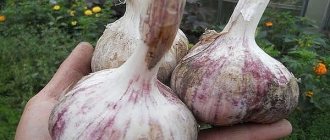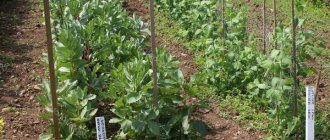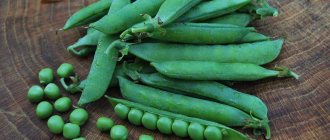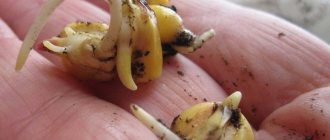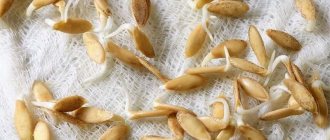Selecting a location, preparing soil and beds for planting
Vegetable peas are divided into sugar and shelling peas. These species differ in whether they use whole pods or only ripe peas for food. At the dacha, sugar varieties are most often planted, but from the point of view of agricultural technology, this is not important; at least, planting any type of pea is carried out almost the same way. Growing this useful vegetable crop is not a problem even for a novice gardener.
Peas are a cold-resistant plant, and they begin to sow them as soon as the ground thaws at least a little after winter, so the bed must be prepared in the fall: in the spring at this time, digging up the plot is still very difficult. The bed can be the smallest size, there can even be several of them, in the most unnecessary areas, but it should be a well-lit place by the sun: in partial shade, peas will also grow, but the yield will be somewhat reduced. It is very good to sow early sugar peas along the paths, where children will be happy to pick them without trampling the plantings.
It is advisable to make a convenient approach for the children to the pea patch
Since peas are sown very densely, they very soon grow into a sort of “forest”; their stems are entwined with grown weeds, and it is not possible to weed them. Therefore, even the most wasteful area must be cleared of weeds, at least perennial ones, in advance. Peas love soils of average composition: loamy and sandy loam. The soil should be moderately fertilized, but peas do not require a lot of nitrogen fertilizers: they provide themselves with this element, extracting it from everywhere and being considered a nitrogen accumulator.
It is best to apply manure (a bucket per 1 m2) under the predecessor, and in the fall dig up a bed for peas with the addition of 20–40 g of superphosphate and 10–20 g of any potash fertilizer. You can replace this mixture with a liter jar of wood ash. If you apply manure directly to planting peas, the bushes grow greatly, branch out, produce crops late, and sometimes become diseased. The best soils in terms of acidity are slightly acidic or neutral; in case of excessive acidity, they are preliminarily limed.
Harvesting
The collection of blades of sugar varieties begins within a week or a week and a half after flowering, since the largest amount of useful substances is contained in the seeds and leaves of young peas. However, uneven ripening, the tendency of ready-made pods to crack, as well as lodging of plants make harvesting peas so difficult that it turns into a very labor-intensive process.
It is better not to pick off the pods, but to cut them with scissors so as not to damage the delicate stems.
After everyone has eaten their fill of young peas, more and more pods remain unharvested on the bushes. This is bad: an unharvested harvest gives plants a signal that they can end their life activity and dry out. To prevent this from happening, pods that are not needed for food are collected for seeds:
- Leave the pods on the bush until fully ripe (the skin should be yellow and dry).
- Each variety is removed into separate containers, making sure that specimens damaged by pea weevil are not caught.
- Then carefully remove the peas from the dry pods and dry them for another week, spreading them out in one layer.
- After harvesting, plant remains are mowed down and placed in compost.
It is not recommended to pull out the roots: over the summer they have accumulated useful nitrogen-containing substances, which, as they rot, will enter the soil and will be used up next year by future plantings.
Video: collecting peas for seeds
Proper planting of peas in a summer cottage almost guarantees a normal harvest: this crop requires only minimal care during cultivation. Having sowed sugar brain varieties in early spring, you can already enjoy vitamin products and delight your children and grandchildren with them at the very beginning of summer.
- Author: Igor Rodiontsev
Graduated from the Faculty of Chemistry of Moscow State University in 1981. Candidate of Chemical Sciences, Associate Professor. Rate this article:
- 5
- 4
- 3
- 2
- 1
(8 votes, average: 3.3 out of 5)
Share with your friends!
Predecessors of peas during planting
Peas are not a fussy plant, and they can be sown after almost any vegetables. The best predecessors are considered to be any pumpkin crops (cucumbers, zucchini, pumpkins), as well as all types of cabbage and potatoes. The pea itself, as well as its related beans, is the best precursor for most known vegetables.
You should not grow peas in one place for several years in a row: the soil after it should be occupied by other crops for 3-4 years. Peas should not be planted after any type of beans.
Features of care
Correct and timely planting is only the initial step on the path to harvesting. It is important to be able to properly care for the crop. The care process consists of a range of activities:
- watering,
- weeding,
- pest control,
- protection from diseases,
- loosening.
And besides this, do I need to tie up the peas? It turns out that it is necessary! So that the leaves do not rot on the ground and are ventilated.
Do I need to pinch peas?
It is customary to pinch the plant so that it grows not only in height, but also produces side shoots. As soon as the peas reach a height of 20-25 cm, their top needs to be torn off. As a result, the crop will become stronger and have more flowers and pods.
Advice: as soon as the first, not yet ripe fruits appear, you need to secure a net over the peas, otherwise the birds will get the harvest!
If you find an error, please select a piece of text and press Ctrl+Enter.
Published in Gardening
Michurinsk, Elena. I read a lot of conflicting recommendations about planting peas. Tell me, do I need to soak peas before planting or is this not necessary ? Peas are one of the most popular crops, represented by several varieties. Many gardeners are engaged in its cultivation. Planting this vegetable has some peculiarities. It is believed that before immersing the seed in the ground, it should be soaked. But how to do it correctly? And is it worth doing such preparation?
Preparing seeds for planting
Peas are often sown with seeds from their own harvest, since by the end of fruiting, interest in them disappears and many unharvested pods remain, which ripen to full condition. This is normal practice in most cases, unless the peas sown were a hybrid (F1): in this case, you can get a completely different harvest than you expected. Often peas are planted with dry, freshly purchased seeds, but it is better to spend a little time preparing them for sowing.
Seed rejection
Even in purchased pea seeds, which are in beautiful bags, there are a small number of unsuitable specimens, and in those grown on your own plot there may be even more of them. Therefore, it is useful to reject the unsuitable ones in advance. Self-harvested peas should be checked for damage: they are often visited by the moth. Such seeds are riddled with holes, inside which you can find traces of pests and even small worms.
You can sort out such seeds manually, sorting them out one by one, but it will be much faster to pour the seeds into salt water (a tablespoon per liter) and wait a couple of minutes. Frail and infected seeds will not sink; they must be collected and discarded. Drowned - rinse with water and dry. After this, you can sow them, but it is better to continue preparation if there is still a little time left before sowing.
Checking seeds for germination
Pea seeds are suitable for sowing for 5–6 years, but only if properly stored, if they are not periodically damp. Therefore, in doubtful cases, it is advisable to check them for germination, and do this in winter, so that if unsuccessful, you have time to buy fresh seeds of the desired variety. For peas, germination is considered good if 9 out of 10 seeds are suitable.
Pea seeds usually germinate easily, but sowing them with roots is very inconvenient
Checking germination is very simple: a dozen seeds are soaked in water for a couple of hours, after which they are transferred to a damp cloth. Place this mini-garden in any container and cover loosely with a lid. Twice a day, check whether the fabric remains damp and add water if necessary.
The peas hatch within a few days, and after a week everything becomes clear: if only one pea has not sprouted, that’s great; two or three are tolerable. If you have sprouted less than five tails, it is better to buy new seeds. Although, if there are a lot of old ones, you can sow them too, only with a reserve, twice as thick as usual.
Is it necessary to soak and germinate seeds?
It is not recommended to soak and germinate pea seeds before sowing. This is especially true for the most delicious and popular brain peas. What is this connected with? Yes, most vegetables sprout better if they are sown with sprouted seeds. But the fact is that peas are sown very early, in cold soil. If it is sown with ungerminated seeds, they will simply wait until the threat of severe frost has passed: somehow the seeds sense this. But if the soil temperature drops below 4 ° C, the young roots of sprouted peas die, and after this the seeds rot.
It makes sense to sow soaked peas only if the early planting dates are hopelessly missed, and you want to get the harvest as soon as possible. If the gardener is sure that the cold will not return and the soil has warmed up enough, then you can put the seeds on a saucer and add water so that it only covers the peas. Soaking time is about 12 hours, and during this period you need to change the water 4-5 times.
The peas will become saturated with water and swell, but this procedure will shorten the time of emergence by a maximum of two days, and only if the soil is moist enough. You should not germinate seeds in the classical sense of the word, that is, until the tails appear: they will be much more difficult to sow, and this will not give a significant gain.
Video: sowing sprouted peas
Seed treatment before sowing
To make the germination of seeds in the garden bed more friendly, they can be warmed up dry near the radiator, placing them next to it in any rag bag for one and a half to two hours. Chemical treatment may be required to prevent the occurrence of diseases if they have ever occurred on the site, but ordinary gardeners almost never do this.
In large agricultural enterprises, peas are pre-treated, for example, with formaldehyde.
Some gardeners before sowing (not in the early stages!) treat the seeds with various preparations containing biologically active substances. In this way, they try to support plants in difficult climatic conditions or slightly increase productivity. Among the most popular drugs are Epin and Humate (drugs with stimulating, adaptogenic and anti-stress effects). Sometimes microfertilizers (zinc, molybdenum, cobalt preparations) are used when preparing seeds. If you do such work, you must do it very carefully, not exceeding the dosage prescribed in the instructions for the chemicals.
Processing time
The duration of the procedure depends on the composition used. The time of traditional soaking of planting material lasts from 6 to 10 hours. The length of time in the solution is determined by the selected germination agent.
When soaking seeds in clean water, you need to take into account that this process will take a lot of time. When using nutrient solutions and growth stimulants, you should carefully study the instructions and recommendations, since stimulating drugs have limited processing times. To avoid disappointment in harvesting, you should know how to soak peas before planting in the soil, whether it is necessary to do this, and what solution is best to use.
Pea planting dates
The ripening time of the first harvest varies greatly depending on the variety, but ordinary summer residents almost always sow early ripening sugar varieties. Their first blades can be picked approximately 45 days after sowing. Therefore, it is possible to calculate sowing dates based on these data. But in practice, peas are sown without hesitation, as soon as the soil allows the rows to be drawn and a few centimeters deepened into it. In the central region of our country, depending on the weather, this can be done in mid or late April.
To prolong the harvest, it is advisable to sow several varieties: the earliest and mid-early ones. But in any case, this must be done as early as possible: peas sown closer to summer germinate and develop worse: they do not like too hot weather. The deadline is mid-June. All pea varieties are amazingly cold-resistant. At the same time, smooth-grained ones germinate at a soil temperature of +1 ° C, while brainy ones require slightly warmer weather. But any air temperature is suitable. For the growth of peas, the optimal temperature is from 12 to 22 ° C.
Some gardeners try to focus their planting dates on the Lunar calendar. Although it should be admitted that in recent years interest in this topic has subsided somewhat, which is also due to the fact that different publications publish very different dates for the same garden work. If we analyze various sources, it turns out that in 2021 the most favorable dates for sowing peas are April 21, 23–28, as well as May 3–5.
Planting dates in different regions
Peas grow well in any climate except very hot ones. If in the central regions of Russia it is sown in April, then in the north - in May, and in the south - already in the first spring month: peas do not like hot weather, and you can get a full harvest only before it arrives. Therefore, for example, in the Krasnodar Territory or the republics of the North Caucasus, peas can be planted at different dates in March, depending on the current weather.
In the Moscow region or in Belarus, where the climate is similar, there are ideal conditions for growing this crop. The timing of sowing peas here is very early; it begins when the soil warms up to 5º C, that is, no later than the May Day holidays. Many gardeners sow seeds two or three times, until about June 10. Ukraine has a varied climate: it is the second largest country in Europe. If in the north the sowing calendar is similar to that of the Moscow region, and peas are sown in the middle or end of April, then in the southern regions this is done already in the last days of March.
Recent Entries
5 working ways to use tar in the garden 7 indoor plants that help you get married even in adulthood Indoor plants that can bloom in trouble
In colder climatic conditions (Siberia, the Urals and the Urals, the North-Western region, including the Leningrad region), it is rarely possible to sow peas before the beginning of May, and in some years the land ripens only closer to the middle of the month.
Plant care
Caring for this unpretentious plant is simple and includes:
- garter,
- watering,
- feeding,
- pest and disease control.
Unlike most garden crops, peas only need loosening and weeding at the beginning of the growing season, while the bushes are very small. It is not possible to loosen the soil between mature bushes due to the thickness of the stems at their base, but adding dry mulch can be done.
It is impossible to loosen and weed adult pea bushes due to the densely growing stems
Weeding grown peas is an almost impossible task: it is dangerous to pull out the weeds by the roots because you can damage the roots of the peas themselves.
Pea supports
Most varieties of peas require mandatory support. A garter is usually not needed; it clings to any sticks and ropes on its own. For low-stemmed varieties, it will be enough to place a palisade of sticks no more than 50 cm high along the edges of the bed and tie twine or wire on them in several rows, and the rows are tied up as the bushes grow.
Video: peas with flowers and pods on a simple trellis
Late varieties of peas grow up to 2 meters or more; tall stakes are needed, so trellises are often installed instead of them. They can be built from any available materials:
- tie a metal or plastic mesh with large cells to the vertical posts;
- drive strong stakes along the edges of the bed and stretch wire between them in several rows, depending on the height of the peas.
You can make a trellis for peas from wooden planks and metal mesh
Watering
In summer, peas need watering (if there is no rain and the soil dries out). This culture is moisture-loving, but can withstand short-term droughts. Plants mainly need water during flowering and when peas are filling. If there is practically no rain, before the peas begin to flower, one watering per week is enough, and after the flowers appear, the frequency of watering should be doubled.
Peas need a lot of water during flowering.
In moderate rainy seasons, most of our country can do without irrigation.
Fertilizers
Fertilizing should also be timed to coincide with watering:
- the first fertilizing is carried out at the beginning of flowering,
- the second - when the first pods appear.
To do this, you need to dissolve a tablespoon of azofoska in a bucket of water and pour this solution over a square meter of garden bed. If you have rotted cow dung, a handful of it can be diluted in a bucket of water and used in the same way the next day. Before and after fertilizing, the beds with peas must be watered.
Treatment against diseases and pests
Peas have many diseases and pests (for example, pea weevil, pea moth), and in summer cottages, prevention consists mainly of carefully observing all the rules of agricultural technology. You can treat plantings several times with folk remedies:
- decoction of capsicum;
- infusions of tobacco, celandine, tomato tops, garlic, wormwood.
Pea weevil larva damages peas in the pod
The process of planting peas for seedlings
To get a very early harvest, peas are sometimes grown through seedlings. True, a lot of space in the apartment must be allocated for this, so they try to prepare seedlings in greenhouses or greenhouses. Any containers in which seeds are sown every 2–3 cm are suitable for this purpose. The composition of the soil does not matter. For sowing, it is better to use early varieties, for example, Early 301 or Viola.
Since there is no need to be afraid of cold weather at home, peas are soaked for 10–12 hours before planting, changing the water periodically. Sowing the seeds itself is not difficult: they are buried to a depth of 3–4 cm, having previously marked frequent grooves, and watered well. Peas sprout in about a week, and seedling care is as simple as keeping the soil moist and monitoring light and temperature conditions. Peas should be in the sunniest place with a temperature no higher than 20 ° C.
The most difficult thing is picking the seedlings, so you can immediately sow them in separate cups, but in the apartment there will certainly be nowhere to put them. In this regard, they often do without picking, but untangling the intertwined roots of neighboring plants is not at all easy.
Sometimes seedlings are grown in so-called hydroponics. To do this, construct a “snail” from toilet paper, which is placed on plastic film, and then the prepared seeds are laid out on the paper, watering generously. After rolling the paper and film into a roll, place it vertically and water it daily.
With this option, the snail should be illuminated for at least 18 hours a day. After two weeks, the seedlings develop good roots, and after a few more days the “snail” is unwrapped, the peas with roots are carefully separated and transplanted into a garden bed.
Already at the stage of cotyledon leaves in toilet paper, peas produce powerful roots
Transplanting seedlings into the ground
Seedlings in a box with soil are ready for planting in 3–4 weeks, earlier in hydroponics. Carefully removing it from the nursery, plant it in pre-prepared beds. In the middle zone this is done in the first half of May, in the south - at the end of April.
The seedlings are planted in deep furrows, well watered. Planting pattern: 10–12 cm in rows and 35–40 cm between them. If the work is carried out in cloudy weather, the seedlings take root well.
Soaking solution
There are several types of solutions used to soak pea seeds before planting.
Solutions used to swell beans usually have a low concentration of active substances. Typically, a few drops of a growth stimulator are added to 1 liter of the swelling mixture. In this case, the temperature of the solution can be quite high (about + 45-50 ° C). This does not pose a danger to the embryo, since the solution cools quickly, and besides, swelling will occur much faster.
An increased concentration of growth stimulants does not make much sense, since only a small amount of liquid will come into contact with the embryo at this stage.
So-called biologically active solutions are used as a soaking liquid during germination. They usually contain various herbs or special preparations. In some cases, the same growth stimulants are used as for swelling of peas.
Typically, a biologically active solution is prepared as follows:
Planting peas in a greenhouse
To grow super early crops, peas are sometimes planted in a greenhouse. Although, of course, a thrifty owner would rather spend precious space growing more heat-loving crops. In unheated greenhouses, including polycarbonate ones, sowing is carried out in March. Only sugar brain varieties are planted in greenhouses, the pods of which you want to enjoy as early as possible.
Of course, there’s not a lot of space in the greenhouse for peas, but ardent lovers will definitely plant a few bushes
Greenhouse growing of peas is no different from ordinary cultivation, except that with the onset of warm weather the greenhouse will have to be constantly ventilated: peas do not like heat. In addition, due to high humidity, peas in a greenhouse often develop powdery mildew. They plant peas in the same way as they do in unprotected soil, but do not rely on rain and water more often. To repel pests, mustard is sown nearby or pre-grown basil seedlings are planted.
Processing time
Processing time depends on many factors:
- type of substance;
- concentration;
- characteristics of the pea variety.
On average, the effect on seeds lasts from 6 to 18 hours. The packaging always contains detailed instructions, which should not be neglected. It is not possible to process the seeds quickly; it is necessary to wait the allotted time.
Before use, the vegetable grower is required to study the manufacturer’s recommendations in detail, otherwise instead of benefit there will be only harm.
Special formulations
It is very useful to soak the peas in a special composition for the first 3 hours. Preparations, including biologically active additives, help make planting material healthier, stronger, and resistant to diseases. Among such means it is worth noting:
- Humate;
- Epin;
- Rizotorfin;
- Nitragin.
Soaked peas germinate faster, but must be planted with caution
The most popular special product is humate, which is essentially a potassium salt obtained from humic acid. The drug has an anti-stress and stimulating effect. The use of humate will ensure early germination of the crop.
Soaking peas is a common procedure. If you follow all its subtleties, the vegetable yield can be significantly increased.
Special preparations are used for various purposes, this is not only the disinfection of seed material, but also the acceleration of biological processes and the activation of the vital forces of the plant. All of them contain active substances, for example, epin. It acts as a growth stimulator and helps peas adapt not only to environmental temperature changes, but also to lighting. Soak the kernels in the solution for up to 7 hours, but not less than five, for it to have a positive effect.
Humate, which is most often prepared from peat, has an anti-stress effect, since in this form it is more effective. Soaking in a solution of potassium salt of humic acid accelerates the process of germination.
Zircon is a good ready-made drug on the modern market. Two drops per 300 ml are enough to provide an effective fungicidal effect. Seeds should be in the solution for 8 to 18 hours. The tool will help:
- increase productivity;
- activates plant growth;
- will help the formation of future seed.
Excellent for seeds with a durable shell, since the main component promotes the penetration of moisture under it.
Such growth stimulants are completely harmless to humans and plants. Produced only on the basis of natural ingredients. In addition to the fact that sprouts make their way into the soil faster, an adult plant becomes less susceptible to:
- temperature changes;
- diseases;
- drought.
Description of culture
The plant belongs to the legume family, therefore it has the ability to enrich the earth with nitrogen. Bacteria (azotobacter and nodule bacteria) develop on the roots, which process nitrogen from the atmosphere and then saturate the soil with it. This feature of legumes has a positive effect on the development of other plants.
Peas have a grassy stem. It can be simple or branched. The branched stem reaches a length of up to 2.5 m. There are varieties that have a small height of up to 60 cm. The branching ones are well suited as a decorative decoration for a gazebo, balcony, or terrace.
Note! The leaves are unpaired; at the ends of the petioles there are tendrils, with the help of which the plant clings to supports for vertical growth.
The flowers are white or purple, look like moths, and are found in the leaf axils in the amount of 1-2 flowers. After sowing, flowering occurs at the age of 40-55 days. The appearance of the first peduncle in early-ripening varieties occurs in 7-8 leaf axils from the root, in late-ripening varieties - in 15-20 axils. The frequency of appearance of flower stalks is 1-2 days. Self-pollination and cross-pollination are possible.
Pea stalk
